-
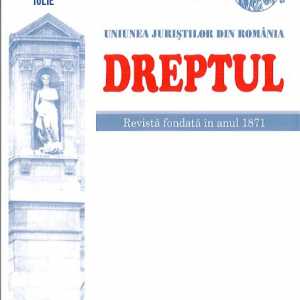 This study begins with on overview of the regulations covering unjust enrichment in French law and the Romanian civil law under the former Civil Code, retaining the fact that its existence as an autonomous source of obligations was, however, recognized and established the Praetorian way. The central part of the study deals with the analysis of the legal regime of unjust enrichment, arising from the express provisions and general rules accounting for relevant general rules under the new Civil Code (Articles 1345-1348); thus, there are set out and debated the conditions of existence of this source of obligations and the admissibility of the action de in rem verso. The author’s approach continues with addressing the unjust enrichment effects and the specific rules applicable to restitutions on this basis. Eventually, it is argued that this autonomous source of obligations is theoretically and philosophically based upon the idea or the principle of fairness.
This study begins with on overview of the regulations covering unjust enrichment in French law and the Romanian civil law under the former Civil Code, retaining the fact that its existence as an autonomous source of obligations was, however, recognized and established the Praetorian way. The central part of the study deals with the analysis of the legal regime of unjust enrichment, arising from the express provisions and general rules accounting for relevant general rules under the new Civil Code (Articles 1345-1348); thus, there are set out and debated the conditions of existence of this source of obligations and the admissibility of the action de in rem verso. The author’s approach continues with addressing the unjust enrichment effects and the specific rules applicable to restitutions on this basis. Eventually, it is argued that this autonomous source of obligations is theoretically and philosophically based upon the idea or the principle of fairness. -
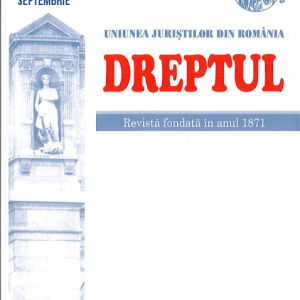 In this study there are analyzed the issues raised by the conclusion and performance of the electronic contracts, also having in view that the cyberspace where they are located has no borders. There are examined, by turns, the regulation of the electronic contract (1); the notion of electronic contract, the notion of electronic means, the classification of electronic contracts (2); the formation of the electronic contract (3); the proof of electronic contract (4); the delocalisation of the electronic contract and its significance for the international trade law (5).
In this study there are analyzed the issues raised by the conclusion and performance of the electronic contracts, also having in view that the cyberspace where they are located has no borders. There are examined, by turns, the regulation of the electronic contract (1); the notion of electronic contract, the notion of electronic means, the classification of electronic contracts (2); the formation of the electronic contract (3); the proof of electronic contract (4); the delocalisation of the electronic contract and its significance for the international trade law (5). -
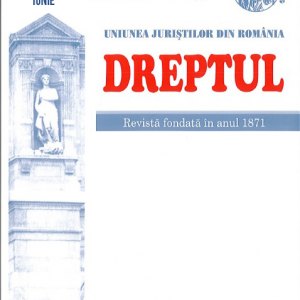 In this article, the authors examine the modality of conducting the procedure of replacement of the measure of preventive detention with the preventive measure of judicial control on bail, respectively if, according to the regulations of the Criminal Procedure Code, at the same time with the admission in principle the judge examines inclusively the grounds of such application or, on the contrary, it requires an initial examination strictly in terms of fulfilment of the formal conditions, finalised with the admission in principle and with fixing the quantum of the bail, and only in the second stage the examination of the application on its merits in terms of its rightfulness. Likewise, there are analyzed the legal remedies against the interlocutory judgment of admission in principle, respectively of the interlocutory judgment whereby the judge rules on the merits of the case. Finally, the authors present the contradictory solutions at the level of different courts of appeal and of the High Court of Cassation and Justice, analyzing inclusively the report drawn up by the supreme court, the Panel for the settlement of some points of law in criminal matters. Likewise, they formulate a series of de lege ferenda proposals, which aim to eliminate the contradictions between the different articles of the Criminal Procedure Code in this matter.
In this article, the authors examine the modality of conducting the procedure of replacement of the measure of preventive detention with the preventive measure of judicial control on bail, respectively if, according to the regulations of the Criminal Procedure Code, at the same time with the admission in principle the judge examines inclusively the grounds of such application or, on the contrary, it requires an initial examination strictly in terms of fulfilment of the formal conditions, finalised with the admission in principle and with fixing the quantum of the bail, and only in the second stage the examination of the application on its merits in terms of its rightfulness. Likewise, there are analyzed the legal remedies against the interlocutory judgment of admission in principle, respectively of the interlocutory judgment whereby the judge rules on the merits of the case. Finally, the authors present the contradictory solutions at the level of different courts of appeal and of the High Court of Cassation and Justice, analyzing inclusively the report drawn up by the supreme court, the Panel for the settlement of some points of law in criminal matters. Likewise, they formulate a series of de lege ferenda proposals, which aim to eliminate the contradictions between the different articles of the Criminal Procedure Code in this matter. -
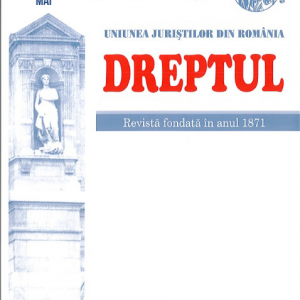 The article deals with the problems of suspension of judgment by the Romanian court based on Article 413 (1) point 1 of the Civil Procedure Code, on the grounds of the existence of a judgment pending before a foreign court.
The article deals with the problems of suspension of judgment by the Romanian court based on Article 413 (1) point 1 of the Civil Procedure Code, on the grounds of the existence of a judgment pending before a foreign court. -
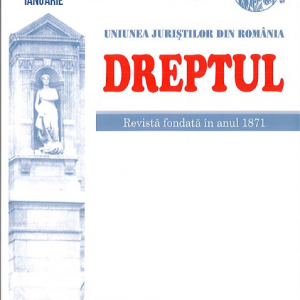 In this article the author raises for discussion some theoretical and practical issues referring to the judicial control and to the judicial control on bail, preventive measures which have been regulated in this form in the new Criminal Procedure Code, focusing on how they are implemented, in order to avoid some errors or confusions related to their interpretation and application.
In this article the author raises for discussion some theoretical and practical issues referring to the judicial control and to the judicial control on bail, preventive measures which have been regulated in this form in the new Criminal Procedure Code, focusing on how they are implemented, in order to avoid some errors or confusions related to their interpretation and application. -
 In this study, the author explains the concepts of: structure of the registered capital; general pledge of the creditors; registered capital; difference between the registered capital and the patrimony of the company; difference between the registered capital and the equity capital (net assets); difference between the registered capital and the value of the company, as well as the problems of the legal regime of social contributions after payments, as all of the above follow from the Law No 31/1990 (republished) on companies.
In this study, the author explains the concepts of: structure of the registered capital; general pledge of the creditors; registered capital; difference between the registered capital and the patrimony of the company; difference between the registered capital and the equity capital (net assets); difference between the registered capital and the value of the company, as well as the problems of the legal regime of social contributions after payments, as all of the above follow from the Law No 31/1990 (republished) on companies. -
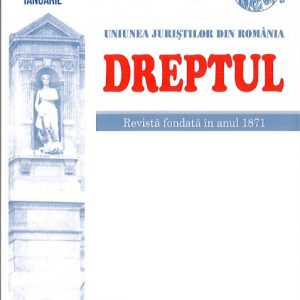 In this study, by analyzing the legal issues of the respect due to persons also after their death, the author, after proceeding to a comparative law examination in the matter, further makes a study of the Romanian legislation in the field under debate (mainly, Articles 78–81 of the new Romanian Civil Code, as well as other legal provisions written down in special laws, such as: the Law No 95/2006 on the reform in the field of healthcare, the Law No 104/2003 on handling of human dead bodies and removal of organs and tissues from the dead bodies in view of transplant and others).
In this study, by analyzing the legal issues of the respect due to persons also after their death, the author, after proceeding to a comparative law examination in the matter, further makes a study of the Romanian legislation in the field under debate (mainly, Articles 78–81 of the new Romanian Civil Code, as well as other legal provisions written down in special laws, such as: the Law No 95/2006 on the reform in the field of healthcare, the Law No 104/2003 on handling of human dead bodies and removal of organs and tissues from the dead bodies in view of transplant and others). -
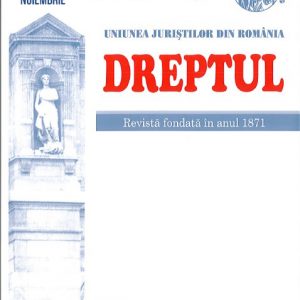 Engaging the civil tort liability has as finality the full reparation of the damage. Reparation is a legal means by which the victim may claim to be reinstated in the situation prior to the commission of the illegal act. The right to reparation depends on an objective fact, that of causing the damage. The condition of the certainty of the damage is its most important character. If the damage is not certain, it can not be ascertained whether the right to reparation arose, and if the uncertainty concerns the extent thereof, the object of the claim for damages can not be established. Sometimes, in practice, it is difficult to determine whether the damage invoked is certain or possible. In relation to this condition of certainty of the damage, the damage by loss of the opportunity to gain an advantage is one of the innovative elements of the new regulation, being outlined as a distinct category of reparable damage.
Engaging the civil tort liability has as finality the full reparation of the damage. Reparation is a legal means by which the victim may claim to be reinstated in the situation prior to the commission of the illegal act. The right to reparation depends on an objective fact, that of causing the damage. The condition of the certainty of the damage is its most important character. If the damage is not certain, it can not be ascertained whether the right to reparation arose, and if the uncertainty concerns the extent thereof, the object of the claim for damages can not be established. Sometimes, in practice, it is difficult to determine whether the damage invoked is certain or possible. In relation to this condition of certainty of the damage, the damage by loss of the opportunity to gain an advantage is one of the innovative elements of the new regulation, being outlined as a distinct category of reparable damage. -
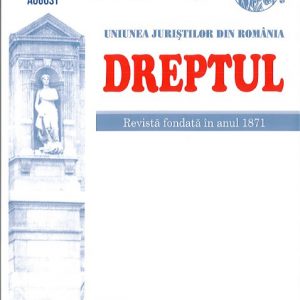 In this study, the author makes an analysis on the right to life, with emphasis on the moment when the right to life begins to flow, including from the phase of conception of human life, by reference to the case law of the European Court of Human Rights and of other courts outside the European Union, following that, in the final part of the study, an analysis be made on the current criminal provisions protecting the right to life in its incipient phase and the compliance of these provisions with the standard required by the Convention.
In this study, the author makes an analysis on the right to life, with emphasis on the moment when the right to life begins to flow, including from the phase of conception of human life, by reference to the case law of the European Court of Human Rights and of other courts outside the European Union, following that, in the final part of the study, an analysis be made on the current criminal provisions protecting the right to life in its incipient phase and the compliance of these provisions with the standard required by the Convention. -
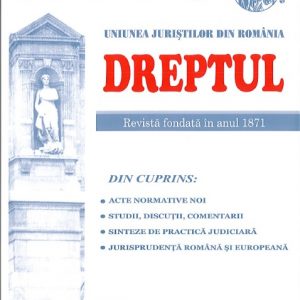 This study appeared as a result of a case solved in practice and identifies legal issues also common to many other cases, which, as always, is subject to the analysis and to the specialised criticism, the latter being accompanied by any other possible points of view.
This study appeared as a result of a case solved in practice and identifies legal issues also common to many other cases, which, as always, is subject to the analysis and to the specialised criticism, the latter being accompanied by any other possible points of view. -
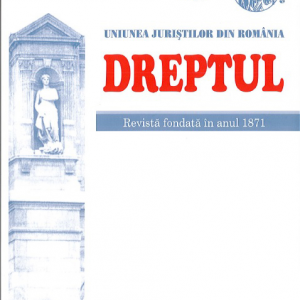 Throughout more than 150 years of constitutional history in Romania, the Romanian constitutions have provided the modality of engaging the liability of the ministers for their activity. This article aims to make a brief analysis of how it was regulated the liability of ministers in the various constitutions which Romania has adopted over time and of the relation between the political and legal liability of ministers in the Romanian law, starting from the practical realities of recent years. Although, traditionally, in the constitutional law it is made a clear distinction between the political and legal liability, in practice, the boundary between the two types of liability is questionable, especially from the perspective of the legal classification of these types of liability. If the political liability is considered to be that liability of ministers before the Parliament for their political activity which may result in the loss of confidence and the removal from the office of minister, the legal liability has in view how a minister should bear the consequences of the law, by his prosecution and indictment.
Throughout more than 150 years of constitutional history in Romania, the Romanian constitutions have provided the modality of engaging the liability of the ministers for their activity. This article aims to make a brief analysis of how it was regulated the liability of ministers in the various constitutions which Romania has adopted over time and of the relation between the political and legal liability of ministers in the Romanian law, starting from the practical realities of recent years. Although, traditionally, in the constitutional law it is made a clear distinction between the political and legal liability, in practice, the boundary between the two types of liability is questionable, especially from the perspective of the legal classification of these types of liability. If the political liability is considered to be that liability of ministers before the Parliament for their political activity which may result in the loss of confidence and the removal from the office of minister, the legal liability has in view how a minister should bear the consequences of the law, by his prosecution and indictment. -
 This article presents the procedural features of the principle non reformatio in pejus in civil procedural area. It aims to concentrate the main theoretical and practical concepts exposed during the time, relating to the limits of this principle. Finally, the study is dedicated to analyze the real interference between different peremptory rules, which govern the appeal, and the principle analyzed.
This article presents the procedural features of the principle non reformatio in pejus in civil procedural area. It aims to concentrate the main theoretical and practical concepts exposed during the time, relating to the limits of this principle. Finally, the study is dedicated to analyze the real interference between different peremptory rules, which govern the appeal, and the principle analyzed.
